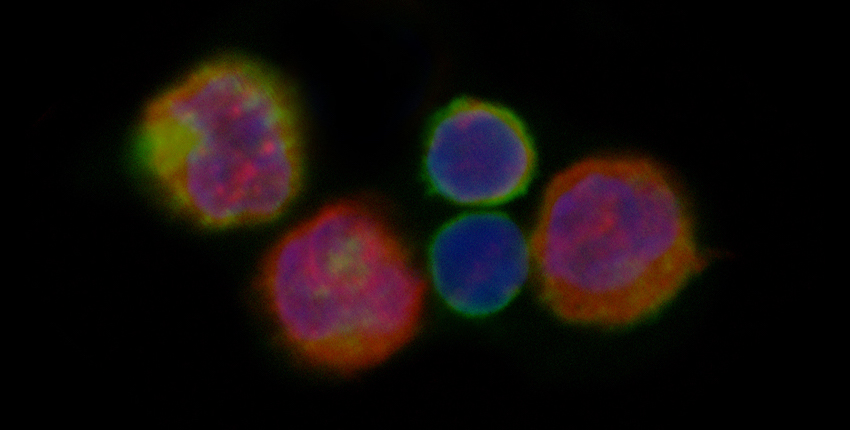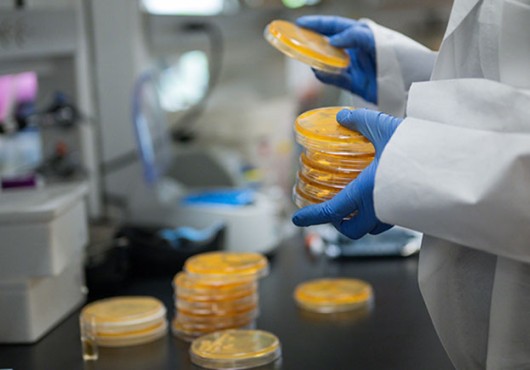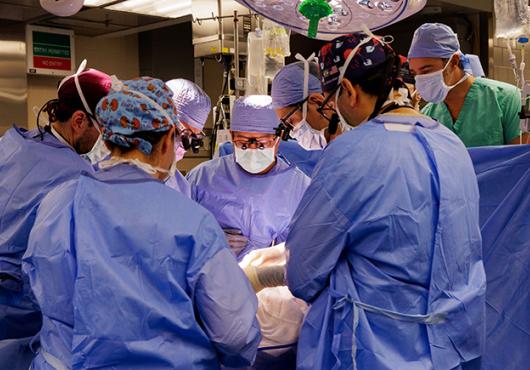
A mixed population of T cells (CD4+ cells) from a mouse. Red stain indicates that DEPTOR is turned on. Cell nuclei appear in blue. Image: Johannes Wedel/Briscoe lab
A pair of new studies led by investigators at Harvard Medical School and Boston Children’s Hospital looks to T cells as paths toward reducing organ transplant rejection and treating autoimmune diseases.
The immune system has two major kinds of T cells. T helper cells, also known as effector T cells, tend to rev up our immune responses, while T regulatory cells tend to suppress or downregulate them.
The first study showed that bolstering populations of T regulatory cells might help people tolerate organ transplants better. The second study found that an imbalance of T helper cells causes an exaggerated immune response that may also contribute to transplant rejection.
The insights could one day help researchers lower the number of organ recipients who lose their transplants despite taking drugs to suppress their inflammatory immune response.
Tipping toward transplant tolerance
The first study, published July 3 in the American Journal of Transplantation, offers a new approach that, perhaps combined with standard immunosuppressant treatment, could greatly enhance people’s long-term transplant tolerance.
Standard immunosuppressive drugs reduce transplant rejection by curbing effector T cell responses. The new study suggests a complementary approach: enhancing and stabilizing T regulatory cells.
The new approach, which has been tested only in mice as yet, works by turning on a gene called DEPTOR, which itself acts as a genetic regulator.
The researchers found that boosting DEPTOR in T regulatory cells enabled heart transplants to survive in mice much longer than usual.
“We got prolonged graft survival in the mice, similar to what you would see with standard immunosuppressants,” said senior author David Briscoe, HMS associate professor of pediatrics and director of the transplant research program at Boston Children’s.
When mice got no treatment at all, their heart transplants survived an average of 7 days. When DEPTOR was turned on in their T cells, survival increased to 35 days.
When DEPTOR enhancement was combined with an immunosuppressive agent—in this case, anti-CD154—the mice appeared to develop true transplant tolerance. Their transplants survived almost indefinitely: 100 days or longer, versus 25 to 30 days with anti-CD154 alone.
In multiple experiments, boosting DEPTOR activity made T regulatory cells more long-lived and functional. While turning DEPTOR on in effector T cells didn’t inhibit organ rejection, doing so in T regulatory cells was enough to tip the immune system toward long-term transplant survival.
Briscoe thinks the study findings also have potential implications for treating autoimmune diseases.
T regulatory cells are not fully functional in autoimmune diseases, he said, so enhancing their stability or activity could help.
“We are interested in identifying specific DEPTOR-enhancing agents and moving this area of research forward in preclinical models,” he said.
A skewed immune response
In addition to pinpointing an imbalance of T helper cells, the second study suggested, in mice and in human cells in a dish, that the imbalance can be reversed pharmacologically.
The findings were published July 16 in the Journal of Clinical Investigation.
Senior author Paolo Fiorina, HMS lecturer on pediatrics, part-time, at Boston Children’s Hospital, first author Francesca D’Addio of the University of Milan and colleagues studied 747 patients who had received a heart transplant, drawing on two Italian studies (AIRT-Bologna and NIT-Bergamo) and an American study (CTOT-05).
Genetic profiling revealed that patients with a mutation in the P2X7R gene were more likely than the others to develop immune events and to reject their transplant. They were also more likely to have major cardiac events within 10 years of transplant and increased coronary artery maximal intimal thickness, an indicator of coronary artery disease.
Immune profiling of blood samples showed that people with these poor outcomes tended to have an altered balance of two kinds of T helper cells. Th2 cell counts were reduced, while Th17 cells, which provoke an especially strong inflammatory immune response, were increased.
The researchers found that the P2X7R protein controls the development of T helper cells into different types by interacting with another protein, NLRP3. Mutations disrupting P2X7R skewed the immune system toward producing an excess of Th17 cells after a transplant.
“Our data suggest that carriers of the mutant P2X7R allele may have a fragile immune system that is at risk of developing a ‘hyper-Th17 syndrome’ when they receive a transplant or when their immune system is stimulated by other means, such as infections, inflammation or tissue damage,” said D’Addio. “This pathway may also favor the development of immune-mediated disorders such as autoimmune diabetes.”
When P2X7R was deleted in mice, the researchers saw the same pattern as in the patients with P2X7R mutations. After heart transplant, Th2 cell production was reduced and Th17 cell production was increased, leading to early graft rejection.
Stimulating P2X7R in human T helper cells in a dish led to activation of NLRP3, the team found. Normally, NLRP3 goes to the cell nucleus to stimulate production of Th2 cells. But when P2X7R was mutated, NLRP3 couldn’t reach the nucleus. This reduced the Th2 cell pool and led to an increase in Th17 cells.
Neutralizing Th17 cells in the mice with an antibody that blocks IL-17, the chemical signal (cytokine) it produces, restored P2X7R/NLRP3 dysfunction to near normal, significantly prolonged graft survival and lowered evidence of post-transplant coronary artery disease. IL-17 blockade also reduced Th17 “skewing” of human T cells in a dish.
“As we have now demonstrated that this axis exists, we have to identify those individuals at risk and establish a therapeutic approach to neutralize it,” said Fiorina. “Two percent of us carry this mutation and may be predisposed to develop unexpected immune diseases.”
Further study will be needed to determine whether dysfunction of the P2X7R/NLRP3 axis contributes to immune disorders in the general population.
Funding and authorship
Briscoe’s study was supported by the National Institutes of Health (R21AI114223 and R01AI136503), an Advancing Research in Transplantation Science Investigator Initiated Grant from Pfizer Inc., the Casey Lee Ball Foundation, the German Research Foundation and Heidelberg University.
Coauthors were Sarah Bruneau, Kaifeng Liu and Sek Won Kong of HMS and Boston Children’s; Peter Sage of HMS; David Sabatini of the Whitehead Institute for Biomedical Research and Mathiue Laplante of Université Laval in Quebec City.
Fiorina’s study was supported by EFSD/Sanofi European Research Programme and an American Heart Association Grant-in-Aid.
Co-authors included Andrea Vergani, Moufida Ben Nasr, Vera Usuelli, Roberto Bassi, Sergio Dellepiane, Sara Tezza, Kaifeng Liu and Gary Visner of Boston Children’s; Sirano Dhe Paganon of the Dana-Farber Cancer Institute; Reza Abdi and Anil Chandraker of Brigham and Women’s Hospital and authors from University Hospital Bologna, University of Milan, University of Parma, Ospedale Papa Giovanni XXIII in Bergamo, Buzzi Children’s Hospital in Milan, University of Cairo, Cleveland Clinic, American University of Beirut and Mount Sinai Hospital.
Adapted from a two-part post on Vector, the Boston Children’s research and clinical innovation blog.





